Downtown Sioux Falls is increasingly known as a center of fun, festivals, activity and excitement. As the centerpiece of our community, it is the place to go to enjoy outdoor dining, arts, culture and major performances. It is a “must see” destination for many residents and visitors.
When the weather is nice, especially on weekends, Phillips Ave between 9th and 12th Streets is one of the most popular gathering spots downtown. It is often crowded with pedestrians enjoying the festive urban environment including the sculptures, restaurants and shops. It is also filled with parked cars and backed up traffic looping through the festivities. While it is thriving, downtown could be even better if we would occasionally limit the intrusion of cars.
Cities around the US and world have been creating pedestrian safe areas for people to congregate and enjoy urban environments. The extent of closures varies based on circumstances. Some are only for a couple evenings a week, or a few hours a day. In others the closure lasts from May to September. Some closures allow cyclists and select wheeled vehicles, while others are reserved solely for pedestrians.
New York’s Open Streets
New York City’s Open Streets program has turned dozens of streets into inclusive public spaces. Some street closures are fully closed and others only partially. In New York the transformations allow for a range of activities that promote economic development, support schools and provide new ways for New Yorkers to enjoy cultural programming and build community.
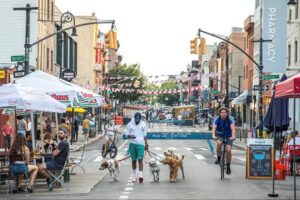
No cars on this street in New York City
Montreal’s Summer Streets
Montreal also enjoys a very successful Summer Streets program which opens streets to pedestrians by limiting access by cars. Since the program began as a temporary experiment, it has expanded both in terms of duration and the number of streets covered. Business owners on streets that aren’t car free reportedly see the kind of increased activity on streets that are, and they want in on it. The Montreal program apparently is spreading from neighborhood to neighborhood as businesses and residents come to appreciate newfound benefits.
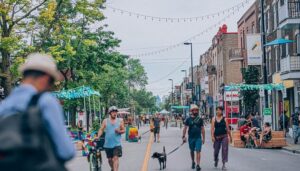
Pedestrian friendly street in Montreal
Retail Spending Increases When a Street is a More Pleasant Place to Be
Montreal’s mayor recently lauded the benefits of his city’s pedestrian-only streets program, underscoring their contribution to the local economy and the sense of community they foster. They have become destinations for tourists, visitors and students. Retail spending tends to increase when you make a street a more pleasant place to be. Temporary or pilot projects increase awareness of the benefits and can make it hard to go back.
Other international cities with pedestrian friendly temporary street closure programs include Paris, Copenhagen, Montreal, Buenos Aires, Tokyo, Barcelona and London.
This concept has become popular across the US as well. Cities with these pedestrian friendly programs include New York, Boston, Denver and Philadelphia. Even smaller, less well-known communities are successfully experimenting with the opportunity. Maybe we should too.
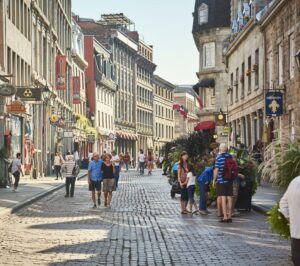
Walkers enjoy streets without cars
Sioux Falls built a pedestrian mall on Phillips Avenue in the 1970s as part of a poorly timed urban renewal effort. It coincided with a period of decline for downtowns nationwide due to the growth of suburban malls. But the tide eventually turned breathing new life into downtowns as suburban malls struggled. Our downtown is bustling now.
Road closures vary in scope and duration, ranging from a few hours once a week to spans of several months. Cities work with businesses and neighborhoods to see what makes sense. In Sioux Falls we already close downtown streets temporarily for parades, races and other special events, so it’s not much of a stretch to consider experimenting like so many other communities are doing.
South Phillips Avenue
On Phillips Ave. I can imagine temporary closures on one, two or all three blocks between 9th and 12th Street. Such a seasonal program could significantly increase foot traffic for area businesses, while making it a more pedestrian friendly place. And downtown has plenty of public parking available now so the temporary loss of a dozen or so spots should not be a major concern.
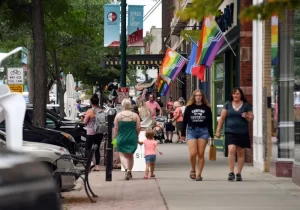
Crowds on Phillips Ave. compete for space with cars
Transforming Phillips Ave into a pedestrian-only haven in the summer would have the added benefit of eliminating the very noisy and offensive parade of cars that can disturb pedestrians, diners, shoppers and residents with their revving engines and stinky exhaust.
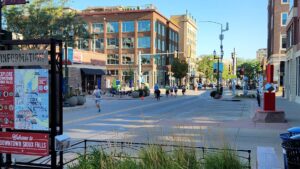
Cars are kept off Phillips for parades, races and other events
Traffic and noise laws have not been enforced much downtown in recent years. The temporary, seasonal closing of streets might reduce the number of such offenses, perhaps freeing the police to assist more with any crowd problems that might result from making the area more accessible to people.
In recent years, downtown Sioux Falls has become a highlight of our community. It is a popular tourist destination, an economic development tool and an attraction for potential new residents. The community has the opportunity to make downtown even more fun and safe by enhancing special areas where people want to congregate.
It’s worth a try.
An intriguing thought
Very interesting thought Joe. Certainly something to consider!
Agree completely. It’s worth a try!
Wonderful idea!!
Could try temporary experience betweeen 3rd Street south to 10th Street for a 3 day trial, I am not sure if it would work south of 10th Street considering you are dealing with S.D Hwy 42. If it works. perhaps you could do an Annual Closure of Phillips Ave of 3rd Street to 10th Street from May 25th to July 25th between Memorial Day and Independence Day…
Really like this idea in the high traffic months…aka summer. Hope SF can at least try it and see what results come from it! Forward thinking!! Thank Joe
Would like to see a 3-way stop at the west end of 12th street…just like at the East end. Would create more safety for all the Pavilion attendees as well. It might even slow down the roar of the Main avenue exhibition and speeding drivers.
I was mayor during the last gasp of urban renewal. That gasp included a permanent closed to traffic, Phillips Av. from 9-11th. When conceived in the late 60s, seemed like a good idea. It wasn’t. Your idea has merit. I suggest closing one weekend a month, shutting off traffic at 5:30 pm Friday until 1am
Sunday morning. Ninth to 12th. Leave traffic open on 11th and 12th. Obviously restaurants will need to have their deliveries received before then. As we deal with our changing environment this can promote cleaner air, and a safer place to enjoy. I vote “aye!”
Apparently you want to turn Phillips Ave. , a street you don’t even live on, into a mini Bourbon St. . The amount of noise, fights and general lewdness that occurs on Phillips Ave at night because of two bars would only increase with the closure of Phillips Ave, and if you think the police don’t write tickets for noise they do even less for the type of shenanigans mentioned above given the number of complaints they get about Pave and Lucky’s. The street is not the problem, the problem is the city’s failure to enforce existing laws.
While the idea of closing one or more blocks of Phillips to break the loop traffic and accompanying noise is appealing -the implementation of it raises many questions to those of us who own property, businesses and reside on Phillips. What are the hours of closure? The highest traffic, noise and exhibition driving is between 10pm and midnight. How do we secure the closures to insure safety -will the Police Dept. staff. How do you deal with cars that were parked and not removed before closure? (tow them or retrieve when street reopens?) Perhaps the greatest concern is what activities fill the street. The 200 & 300 blocks of Phillips already have a street scene in front of Luckies and Pave. Closing the streets would likely result in an increase of this scene and the negative behavior that comes with it.
I agree the Police Department has not been willing to enforce vehicular noise and exhibition driving violations. In addition the City and the Police have shown little interest in enforcing rules and regulations with liquor licenses. Things like, allowing people to walk down the street with drinks, serving after 2am, loud amplified music after 11am. So expecting them to provide security for closed streets might be unrealistic.
Without a willingness to enforce traffic and noise violations the problem will continue to persist on tenth and eleventh streets.